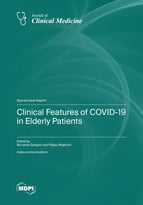Clinical Features of COVID-19 in Elderly Patients
A special issue of Journal of Clinical Medicine (ISSN 2077-0383). This special issue belongs to the section "Epidemiology & Public Health".
Deadline for manuscript submissions: closed (25 January 2023) | Viewed by 32552
Special Issue Editors
2. IRCCS Istituto Ortopedico Galeazzi, 20161 Milan, Italy
Interests: orthopedics; traumatology; osteoarthritis; regenerative medicine; basic science; osteoporosis; artificial intelligence
Special Issues, Collections and Topics in MDPI journals
Interests: orthopedics; traumatology; meta-analysis; medical statistics; regenerative medicine; biomechanics
Special Issues, Collections and Topics in MDPI journals
Special Issue Information
Dear Colleagues,
The COVID-19 pandemic has dramatically revolutionized our lives, also significantly changing our work dynamics across all medical disciplines. Due to the intrinsic characteristics of this infection, the elderly have been shown to be particularly at risk. In fact, due to their reduced resilience capacity and their fragility, coronavirus has found fertile ground in this segment of the population.
It is, therefore, of particular importance to recognize the clinical characteristics of this pathology in the subjects most at risk—the elderly.
Taking care of the sick is our mission, and even more, protecting people who are by definition the weakest deserves our attention and commitment.
In this Special Issue, we hope to encourage proposals that critically analyze and discuss current knowledge on the clinical characteristics of this infection, focusing on the elderly and the specific problems associated with this population. Original papers are welcome, as well as translational research papers.
Dr. Riccardo Giorgino
Dr. Filippo Migliorini
Guest Editor
Manuscript Submission Information
Manuscripts should be submitted online at www.mdpi.com by registering and logging in to this website. Once you are registered, click here to go to the submission form. Manuscripts can be submitted until the deadline. All submissions that pass pre-check are peer-reviewed. Accepted papers will be published continuously in the journal (as soon as accepted) and will be listed together on the special issue website. Research articles, review articles as well as short communications are invited. For planned papers, a title and short abstract (about 100 words) can be sent to the Editorial Office for announcement on this website.
Submitted manuscripts should not have been published previously, nor be under consideration for publication elsewhere (except conference proceedings papers). All manuscripts are thoroughly refereed through a single-blind peer-review process. A guide for authors and other relevant information for submission of manuscripts is available on the Instructions for Authors page. Journal of Clinical Medicine is an international peer-reviewed open access semimonthly journal published by MDPI.
Please visit the Instructions for Authors page before submitting a manuscript. The Article Processing Charge (APC) for publication in this open access journal is 2600 CHF (Swiss Francs). Submitted papers should be well formatted and use good English. Authors may use MDPI's English editing service prior to publication or during author revisions.
Keywords
- COVID-19
- SARS-CoV-2
- clinical features
- public health
- elderly








